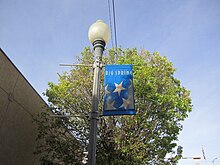Big Spring, Texas
"[7] The area had long been a popular watering hole for Native American residents and nomads, including members of the more recently established Jumano, Apache, and Comanche tribes.
During the 1840s and 1850s, Big Spring was often where Comanches assembled and organized themselves before departing on large-scale raids into northern Mexico during the Comanche-Mexico Wars.
Finch purchased 37,000 acres (150 km2) of ranchland in the area in 1883, and is credited with building Big Spring's first permanent structure, a butcher shop.
Big Spring was featured in the 1969 film Midnight Cowboy, which starred Dustin Hoffman and Jon Voight, and received the Academy Award for Best Picture of 1969.
The opening scenes featuring Voight, then a relatively unknown actor, playing the character Joe Buck, were filmed in Big Spring and the neighboring city of Stanton.
In 1980, Hollywood returned to Big Spring with the filming of Hangar 18,[13] a low-budget science-fiction movie about a space shuttle's collision with an alien spacecraft and the ensuing government cover-up.
In 1999, a New York energy company erected the first 80-metre (260 ft) tower for one of North America's largest wind turbines for that time at Big Spring.
In the early 1840s, it was the center of a territorial dispute between Comanche and Pawnee tribes, and has been a major watering hole for wildlife and prehistoric people in this semiarid area.
[17] Early military scouting reports and pioneer accounts describe the water as cold, clear, and dependable; the spring pool was about 15 ft (5 m) deep, with the overflow going only a short distance down the draw before it sank beneath the surface.
Long used by regional inhabitants, both permanent and nomadic, with a large number of locally collected artifacts testifying to its heavy occupation, the spring sat astride the several branches of the later-developed Comanche War Trail as they converged on this important water hole from beyond Texas, coming south across the Northern Plains and the Llano Estacado.
[17] The spring aquifer held a large quantity of water due to the great number of fractures, solution channels, and interstices in the rocks and underlying sands, although the areal extent of the Big Spring sink is estimated to be only 1 mi (2 km) in diameter, with the main area only 3,000 ft (914 m) wide and almost circular, with some ellipticity trending towards the west.
In a passing comment, enigmatic in its content and disappointing in its brevity, the report states no other comparable deep sinks formed elsewhere on the Edwards Plateau.
The same publication suggests the spring's discharge volume was in excess of 100,000 U.S. gallons (378,541 L) per day at the time of the railroad's arrival in the area in the late 1880s.
The city now artificially fills the spring from its current source of water as a means of allowing residents and visitors to maintain some idea of how it appeared in times past.
Big Spring is located slightly south of the center of Howard County in the valley of Beals Creek, an eastward-flowing tributary of the Colorado River.









